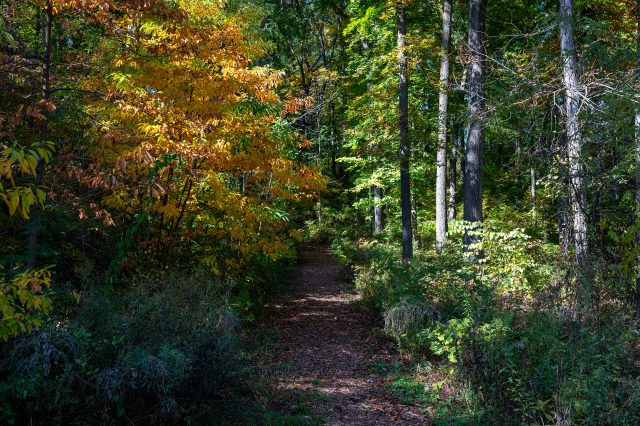[ad_1]
The University of Michigan officially proposed the Campus Connector in September, a transportation plan that aims to make commuting between Central, North, Medical Campuses easier. The plan is part of the Campus Plan 2050, a blueprint for the next 30 years of the Ann Arbor campus. The Automated Transit System aims to reduce congestion, support carbon neutrality and provide efficient transit between campuses. Ann Arbor community members have voiced concern about the proposal, saying it could cause irreversible damage to the Nichols Arboretum, a nature area adjacent to the University’s campus in Ann Arbor. On the Diag Thursday, residents and environmental advocates handed out informational flyers to raise awareness about the environmental impacts of the proposed ATS route. As presented now, the transit system would pass through parts of the Arb, including the W.E. Upjohn Peony Garden and Schoolgirls’ Glen.
Bob Grese, former director of the Matthaei Botanical Gardens and Nichols Arboretum wrote a letter to University President Santa Ono opposing the ATS route. He raised concerns about the path’s proposed location through Schoolgirls’ Glen, a particularly fragile area of the Arb, in an email to The Michigan Daily.
“The School Girls’ Glen is a very fragile landscape made up of glacial deposits highly vulnerable to erosion,” Grese wrote. “It also supports a diversity of trees and provides habitat for a wide range of birds, including many migrating warblers.”
Grese further elaborated that erosion in the Glen has been an ongoing issue, aggravated by stormwater runoff from nearby University infrastructure.
“As the University created parking lots and buildings in the watershed along Washington Heights without storage facilities for storm water runoff, erosion in the ravine has been unrelenting,” Grese wrote. “Instead of locating new and potentially damaging infrastructure in the Glen, the University and City should work to reduce the storm water runoff reaching the Glen and causing such damaging erosion and be working to repair the damage already done.”
In an interview with The Michigan Daily, Rita Mitchell, volunteer chair of the Ann Arbor Environmental Commission, also opposed the project, citing harm to the Arb’s ecosystems.
“A monorail would require cutting trees along an easement in order to complete construction,” Mitchell said. “The cut easement would fragment the area that provides significant habitat for wildlife. It will introduce noise and light. It will open pathways for invasive plants that will further reduce our local biodiversity, which is already greatly challenged by climate change and other human-caused disturbances.”
LSA junior Ali Ghoul, who stopped to speak with advocates on the Diag, emphasized the importance of preserving natural spaces like the Arboretum in an interview with The Daily. Ghoul expressed that the area represents more than just green space and carries cultural meaning for many.
“I think preserving something like the Arb, like a natural piece, is really important, something that we should probably take care of,” Ghoul said. “Ann Arbor is a city that is known for preserving its nature and preserving its heritage because there’s a lot of native tribes. I think preserving these natural pieces, big plots of land … It holds onto the nature, but also the memories of those around the land.”
University spokesperson Kay Jarvis clarified that the plans are still flexible and evolving in an email to The Daily.
“Information will continue to be added to the Campus Plan 2050 website, which provides more details on the transit concept and an updated map that reflects one possible corridor, rather than a chosen or final route,” Jarvis wrote. “Work to refine the possibilities took place over the years, and much more exploration is ahead to determine transit routes, select equipment, and receive approvals, all of which would have to take place before construction could begin.”
The University’s engagement process for the Campus Plan 2050 has drawn criticism from some community members, who feel that it does not adequately prioritize environmental stewardship.
Grese expressed disappointment with the planning process, stating that the project appears to conflict with the University’s sustainability goals.
“To me, it also undermines the University’s own sustainable goals when the biological diversity, carbon storage, and wildlife habitat found in places like the Arboretum might be sacrificed to meet transportation needs,” Grese said. “In my mind, some commitment to preserving biological diversity and the stewardship of all of these areas is lacking in what I’ve seen so far in the Campus Plan 2050 outreach.”
Jarvis further emphasized the University’s commitment to sustainability and ecological preservation.
“The University of Michigan has a long tradition for stewarding its natural spaces, including Nichols Arboretum,” Jarvis wrote. “The campus planning processes prioritize sustainability, health and wellness, and landscape and open spaces. It remains a priority to the university to preserve Nichols Arboretum, along with the preservation of our other highest quality ecological resources and other valuable open spaces.”
Daily Staff Reporter Emma Spring can be reached at sprinemm@umich.edu.
Related articles
[ad_2]
Source link











